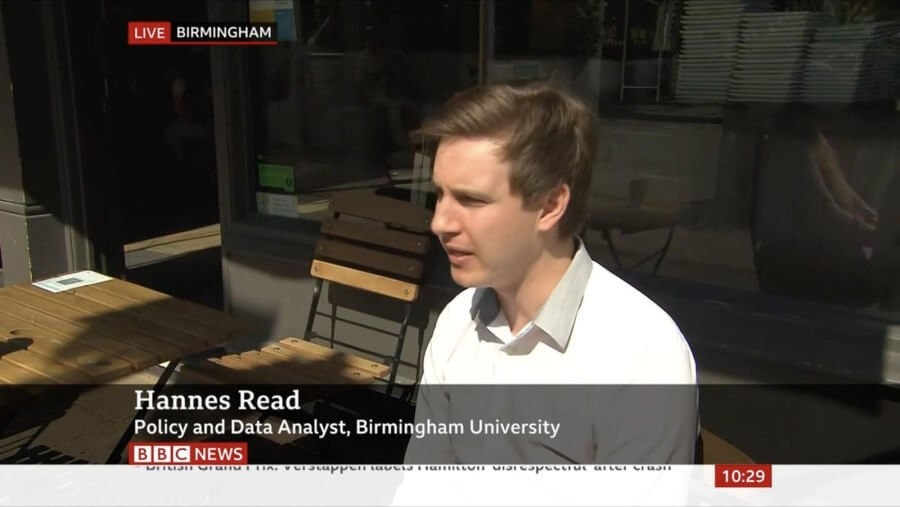 Hannes Read discusses a study looking at the impacts of COVID-19 on business districts and working practices, and what the way forward might be.
Hannes Read discusses a study looking at the impacts of COVID-19 on business districts and working practices, and what the way forward might be.
The Future Business District Study
Since the Covid-19 pandemic, many people and businesses have been required to work from home rather than the office. The sudden shift away from working in the office has significantly impacted the Business, Professional & Financial Services (BPFS) sector.
As the UK looks to emerge out the other side of the pandemic, City-REDI at the University of Birmingham have been working alongside Colmore Business Improvement District (BID) in Birmingham city centre in a unique study on The Future Business District. The aims of the project are to inform the response to long term recovery from the Covid-19 pandemic and to offer policy directions on best practice for BIDs to adapt to the changes in future.
The Accelerating Trend in Hybrid Working
The director of policy and research at the Centre for Cities, Paul Swinney, has recently appeared on the Wake up to Money programme on BBC Radio 5 Live claiming that, in the long term, we will see a return to the office five days a week. Yet, even prior to the pandemic, many people in the BPFS sector were not working full time in the office. The ‘flexible’ or ‘hybrid’ working that many people have become accustomed to recently was already underway; what the Covid-19 pandemic has done is accelerate those existing trends. So, the wheels were already in motion to move away from a five-day office week. A move back to pre-pandemic trends would still include a growing portion of remote working.
This is not to say that the office will become redundant, however. As identified by Paul Swinney, there are many benefits to being in the office, which is likely to persist and remain important. The networking, collaborations and ideas sparked by face-to-face interactions cannot be easily replicated virtually. Younger people, in particular, can have plenty to gain from meeting in person in the office.
“[Learning is] human nature, the end of the day. How the heck can the young people learn, you know. We’re learning, I’m always learning. You can’t learn by using these zoom screens, you know, it’s those interactions are conversations that actually are the most productive learning process within office space.” (Interview participant, 2021).
There are opportunities for younger people to learn good practice and building connections from meeting face-to-face. Exactly how the office space is used is more open for discussion. Yet our research has found it is likely to evolve to better capture the benefits of office-working, with more break-out rooms, areas for collaboration spaces and a greater emphasis on leisure.

The Journey to the Future Business District
Almost all the businesses, developers, and organisations we spoke to as part of the Future Business District study considered hybrid working to be here to stay, in some form. Whilst exactly how to coordinate and manage some people working part from home and part from the office is less clear in practice, the intention is certainly there. Still, teething problems may need to be worked out. For example, if the decision was left to employees to choose when they may come into the office, there could be a larger number of younger people going into the office on a Friday in anticipation of post-work drinks at the end of the week. And by the same token, there may be few people coming in on a Monday to ease themselves into the week. The uneven demand for office working can be at odds with some businesses acting to reduce the supply of office space.
Still, there is evidence from the Future Business District study that, in Birmingham, there is demand from both businesses and employers for a high-quality office space.
“[The future office is] much more about shared knowledge, inspiration, and breakout spaces and also quiet areas as well … They created a quality environment … The big point is the flight to quality.” (Interview participant, 2021)
The demand for good quality meeting rooms, collaboration spaces and breakout rooms is likely to increase. The considerations for energy efficiency, carbon zero building materials, sustainable transport infrastructure and parking, are also on the increase. Developers and businesses have planned for these trends already and the demand for high-quality office facilities is likely to continue to increase in the aftermath of the pandemic. Likening the office to a ‘destination’ is one way to encourage people to come into the office space and facilitate collaborations between people.
Role of BIDs in the Future Business District
There are implications facing the wider business district as a result of the shift to hybrid working and an increase in demand for high-quality office space. The findings from the Future Business District study shows that the way in which businesses and people will work and interact in the office is likely to change. Yet office working is unlikely to return quickly to something more akin to 2019. Hybrid working, where people work from home part of the week and from the office the rest of the time, is likely to continue to be the norm. The shifting office use towards a high-quality destination with greater collaboration and networking space is an opportunity to adapt to the changes. BIDs and other place-focused organisations have a significant role to play in facilitating a smooth and practical transition in the way hybrid working and new office uses. It cannot be ignored that many lower grade offices may become less attractive too in future. But plans for how they can be used in future, such as public indoor spaces, or education spaces could help bring an attraction to those areas. Encouraging the office and the wider city centre to become a destination where people can come in has wider benefits for the broader city centre ecosystem.
The changing business district can be seen as a journey. It is unlikely there will be a point where we ‘arrive’ at the trends facing the future city centre. But there can be a series of iterations and learning about what works well for businesses and the work-life balance of employees. Leadership organisations such as BIDs and local authorities from across the city centre are vital in working with businesses and organisations to adapt to the changes for the future business district.
This blog was written by Hannes Read, Project Policy and Data Analyst, City-REDI / WMREDI, University of Birmingham and was first posted on the Birmingham Business School Blog.
Disclaimer:
The views expressed in this analysis post are those of the authors and not necessarily those of City-REDI or the University of Birmingham.
